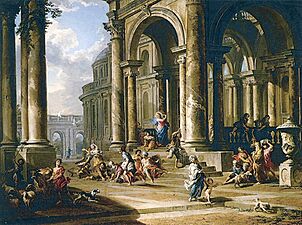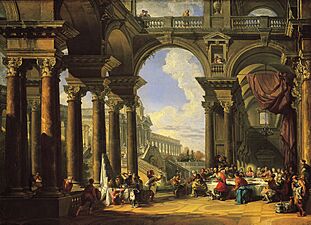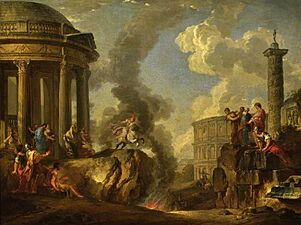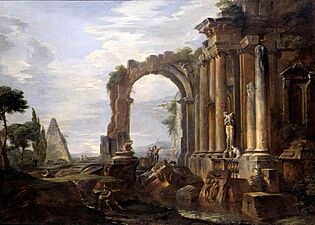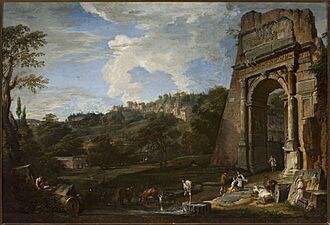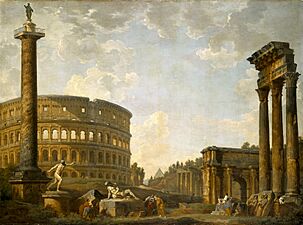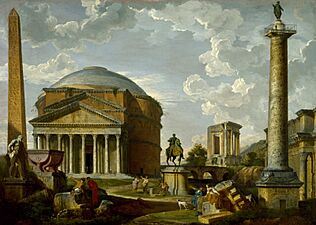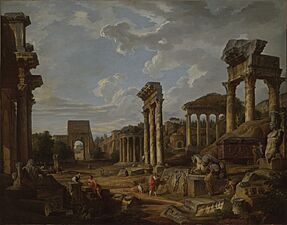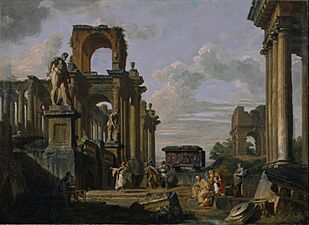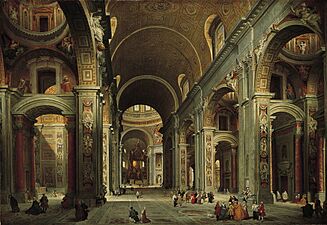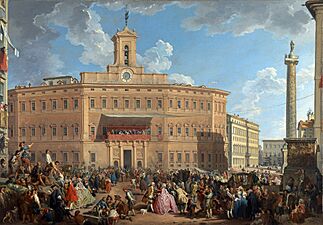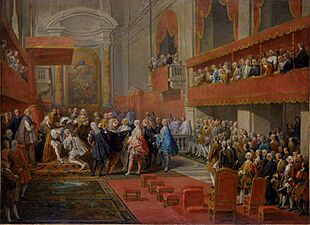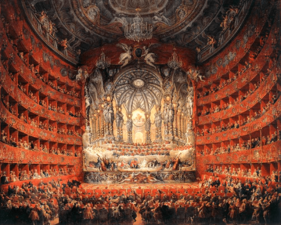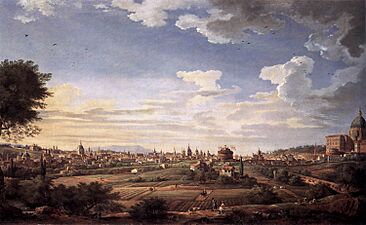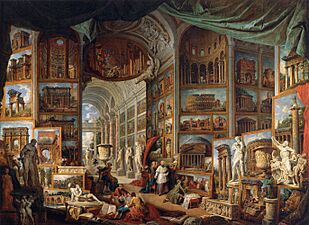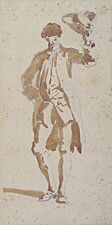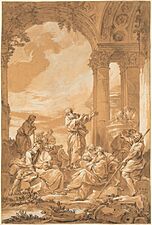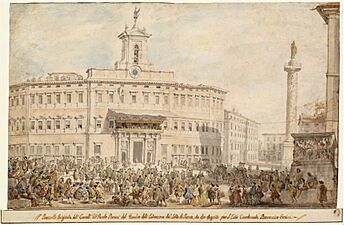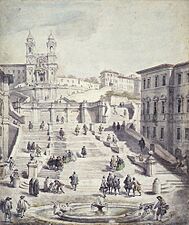Giovanni Paolo Panini facts for kids
Quick facts for kids
Giovanni Paolo Panini
|
|
|---|---|
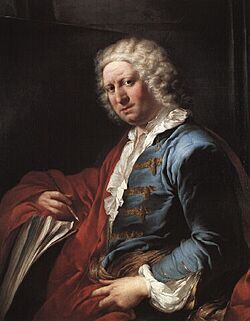
Portrait of Panini by Louis Gabriel Blanchet
|
|
| Born | 17 June 1691 |
| Died | 21 October 1765 (aged 74) |
| Nationality | Italian |
| Other names | Gian Paolo Panini/Pannini |
| Movement | Baroque |
Giovanni Paolo Panini (born June 17, 1691 – died October 21, 1765) was a famous Italian painter and architect. He is best known for his amazing paintings of Rome. These paintings often showed beautiful views of the city.
Panini was especially interested in ancient Roman buildings. He painted many scenes of Rome's old ruins. His most famous works include a painting of the inside of the Pantheon. He also created paintings that looked like art galleries filled with views of Rome. Many of his works, especially those with ruins, had a dream-like or imaginary feel. This style is called capriccio. Panini also painted portraits, like one of Pope Benedict XIV.
Contents
Panini's Life Story
As a young man, Panini learned to paint in his hometown of Piacenza, Italy. He studied with artists like Giuseppe Natali and Andrea Galluzzi. He also learned from a stage designer named Francesco Galli-Bibiena.
In 1711, Panini moved to Rome. There, he continued to study drawing with Benedetto Luti. In 1724, he married Miss Gossert. Her brother-in-law, Wengkels, was in charge of the French Academy in Rome. Panini and his wife had two sons, Giuseppe and Francesco, who also became artists.
In Rome, Panini became well-known for decorating palaces. He worked on places like the Villa Patrizi and the Palazzo de Carolis. In 1719, he joined an important art group called the Congregazione dei Virtuosi al Pantheon. He taught art at the Accademia di San Luca and the Académie de France in Rome. He even influenced a famous French painter named Jean-Honoré Fragonard. In 1754, Panini became the director of the Accademia di San Luca.
Kings and queens in Spain really liked his art. The Spanish King Carlos IV bought many of his paintings. These artworks are still kept in the Prado Museum today.
Panini passed away in Rome on October 21, 1765.
Panini's Influence on Art
Panini's art studio was a place where other artists learned. His son Francesco Panini and a painter named Hubert Robert studied there. Panini's unique style of painting city views influenced many other artists. These included his students Antonio Joli and Charles-Louis Clérisseau. Even famous painters like Canaletto and Bernardo Bellotto were inspired by him. They all helped create "painted postcards" for visitors to Italy.
Panini was not just a painter and architect. He also taught about perspective and optics at the French Academy of Rome. His amazing use of perspective later inspired something called the "Panini Projection". This is a special way to create wide, panoramic views.
You can see Panini's artworks in many museums around the world. Some of these include the Prado Museum, the Louvre, the Hermitage, and the Metropolitan Museum of Art.
Gallery
History Paintings
-
The Wedding at Cana (c. 1725), oil on canvas, 99.2 × 137.2 cm., Speed Art Museum
-
Marcus Curtius Leaping into the Gulf (no date), oil on canvas, 73.7 x 98.1 cm., Fitzwilliam Museum
Capriccios
-
Roman Capriccio: The Colosseum and Other Monuments (1735), oil on canvas, 98.4 x 133 cm., Indianapolis Museum of Art
-
A Capriccio of Roman Ruins (1737), oil on canvas, 36.8 x 69.2 cm., Fitzwilliam Museum
-
Fantasy View with the Pantheon and other Monuments of Ancient Rome (1737), oil on canvas, 99 x 137.5 cm., Museum of Fine Arts, Houston
-
St Sibyl's Sermon in Roman Ruins with the Statue of Apollo (1740s), oil on canvas, 81 x 125 cm., Hermitage Museum
-
Architectural Capriccio of the Roman Forum with Philosophers and Soldiers (1745-50), oil on canvas, 98.4 x 135 cm., National Museum of Western Art
Veduta (Contemporary Rome)
-
Piazza Navona in Rome (1729), oil on canvas, 107 x 248 cm., Louvre
-
The Nave of St. Peter's Basilica in the Vatican (1735), oil on canvas, 153 x 219.7 cm., Norton Simon Museum
-
Lotteria in Piazza di Montecitorio (1743), oil on canvas, National Gallery
-
Musical feast given by the cardinal de La Rochefoucauld in the Teatro Argentina in Rome in 1747 on the occasion of the marriage of Dauphin, son of Louis XV (1747), oil on canvas, 207 x 247 cm., Louvre
-
Gallery of Views of Ancient Rome (1758), oil on canvas, 203 x 300 cm., Louvre
Drawings
-
Man Shading His Face with a Tricorne (no date), brown wash, over graphite, 21.6 x 10.6cm., Metropolitan Museum of Art
-
Saint Paul Preaching in Athens, 1734, National Gallery of Art
-
The Lottery in Piazza di Montecitorio (1743-44), Pen, ink, watercolor, graphite, 34 x 54.5cm., Metropolitan Museum of Art
-
Staircase of the Trinity of Mont (ca. 1756-58), Pen, ink, wash, watercolor, and graphite, 34.8 x 29.3 cm., Metropolitan Museum of Art
-
Arch of Titus (no date), pen, ink and wash, 18.7 x 12.2 cm., National Gallery of Art
-
Ruins of a Basilica or Mausoleum (no date),Pen, ink, and wash, 31 x 20.6cm., Metropolitan Museum of Art



